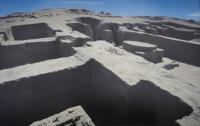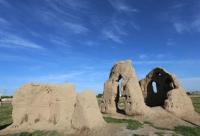You are here
Ancient Termez.



Tours to Termez.
«Memory is the treasure house of the mind wherein the monuments thereof are kept and preserved»
Thomas Fuller.
History of Termez.
The town Pap is situated on the cone of ejection of river Gavasai. Diggings of numerous mounds in surroundings of the town allowed to find out that Bab (Pap) was a big handicraft centre in Middle Ages where lived substantially pot makers and smiths.
Major regional city, near which there are settlement of Old Termez, formed in ancient river crossing, on the banks of the Amu Darya. Termez base dates back to the III-II cent. BC, when there is a strengthening of (feces), enclosed by walls.
In the first centuries AD the ancient city is growing in breadth, it distinguished residential and industrial neighborhoods, religious complexes, in particular the major Buddhist monasteries (Kara-Tepe and Fayaz-Tepe).
The flowering of medieval Termez comes in X - XII centuries. When expanding the total area formed suburbs-rabad, erected many buildings of the civil and religious architecture (archaeologists opened a mosque and minaret Char Sutun (XI cent.) Palace of Termez rulers (XI-XII cc.) ornate carved pieces).
City dies at Mongol conquest in the early XIII century. But once again composed the original to the east of the XV century. (now the land of the village Namuna). At the sites of Old Termez remains of city walls, the ancient citadel, next quarter, monumental architecture.
Nowadays Pap is the centre of agricultural region. Cotton is grown everywhere and angora goats are bred in this Termez. The territory of Surkhandarya thanks to convenient condition for agriculture attracted ancient man thousands years ago.
But until first states appeared there were just separated settlements. Due to very favorable position on the banks of Amudarya, where a large island and shallows offered a convenient crossing of the mile-wide river, this territory became important strategic point, dividing mountainous Baktria and agricultural oases of Sogd.
Ancient Persian kings and Alexander the Great, the Kushans and the Hephtalites, all strove to set control over this territory. Greeks brought Hellenic culture, Kushans – art of Gandahara and Buddhism.
During the Kushan’s reign many Buddhist monasteries were built around Termez, ruins of some of them remained till today. In the mid-seventh century the city was conquered by the Arabs and was included in Transoxiana.
Under the Arabs the city became a major Muslim religious center, while at the same time the secular element remained so vibrant that the noise from Termez, so the story goes, could be heard in Balkh, 70 km south of the river.
The X and XI century saw another high point in the development of the city when under nominal rule of Bukharan Samanids Termez reached its zenith. But already in XII century the city went through hard times.
One ruling dynasty replaced another until in 1220 after 11-days siege the Mongols took Termez and razed it to dust. After that the curtains closed on Old Termez. But survivors didn’t leave and built new city several kilometers away from ruins of Old Termez.
The cultural development of Bactria has now been researched for over 100 years. A wealth of excavations and remnants of the past were dug up during archaeological expeditions by a number of international teams.
Today we have quite a clear picture and excellent insights into this fascinating civilization that blossomed during late antiquity in the south of Uzbekistan, along the Amudarya river.
Bactrian art distinguishes itself through its blend of locally established culture with greco-roman influences, brought to the area by the campaigns of Alexander the Great. Subsequently, the territory was conquered by the nomadic Yu-chi tribe, who founded five kingdoms out of which the Kushan empire arose.
The introduction of Bud-dhism, the symbiosis of Buddhist Gandhara Art and the greco-roman elements led to one of greatest cultures in history. Thanks to brisk trade the city revived again. Termez continued to flourish under the Temurids but was destroyed at the end of the XVII century.
The present town was rebuilt in 1897 as a Russian fort and garrison. And for the last 80 years Termez has been one of the furthest and most sensitive sealed outposts of the Soviet Empire, enforcing an unnatural religious region.
Authority:
«The Guidebook on historical and cultural places of interest of the Surkhan-Darya area and the city of Termez». 2011.







